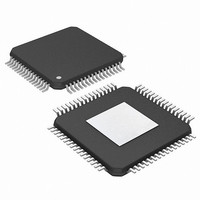PIC24FJ256DA206-I/MR Microchip Technology, PIC24FJ256DA206-I/MR Datasheet - Page 355

PIC24FJ256DA206-I/MR
Manufacturer Part Number
PIC24FJ256DA206-I/MR
Description
MCU PIC 16BIT FLASH 256K 64VQFN
Manufacturer
Microchip Technology
Series
PIC® 24Fr
Specifications of PIC24FJ256DA206-I/MR
Program Memory Type
FLASH
Program Memory Size
256KB (85.5K x 24)
Package / Case
64-VFQFN, Exposed Pad
Core Processor
PIC
Core Size
16-Bit
Speed
32MHz
Connectivity
I²C, IrDA, SPI, UART/USART, USB OTG
Peripherals
Brown-out Detect/Reset, GFX, LVD, POR, PWM, WDT
Number Of I /o
52
Ram Size
96K x 8
Voltage - Supply (vcc/vdd)
2.2 V ~ 3.6 V
Data Converters
A/D 16x10b
Oscillator Type
Internal
Operating Temperature
-40°C ~ 85°C
Processor Series
PIC24FJ
Core
PIC
Data Bus Width
16 bit
Data Ram Size
96 KB
Interface Type
UART, SPI, USB, I2C, RS-485, RS-232
Maximum Clock Frequency
32 MHz
Number Of Programmable I/os
23
Number Of Timers
5
Operating Supply Voltage
3.6 V
Maximum Operating Temperature
+ 85 C
Mounting Style
SMD/SMT
3rd Party Development Tools
52713-733, 52714-737, 53276-922, EWDSPIC
Development Tools By Supplier
PG164130, DV164035, DV244005, DV164005, AC164127-4, AC164127-6, AC164139, DM240001, DM240312, DV164039
Minimum Operating Temperature
- 40 C
Lead Free Status / RoHS Status
Lead free / RoHS Compliant
Eeprom Size
-
Lead Free Status / Rohs Status
Lead free / RoHS Compliant
- Current page: 355 of 408
- Download datasheet (4Mb)
27.2.3
When
PIC24FJ256DA210 family devices also have a simple
brown-out capability. If the voltage supplied to the reg-
ulator is inadequate to maintain the output level, the
regulator Reset circuitry will generate a Brown-out
Reset. This event is captured by the BOR (RCON<1>)
flag bit. The brown-out voltage specifications are
provided in Section 7. “Reset” (DS39712) in the
“PIC24F Family Reference Manual”.
27.2.4
When enabled, the on-chip regulator always consumes
a small incremental amount of current over I
including when the device is in Sleep mode, even
though the core digital logic does not require power. To
provide additional savings in applications where power
resources are critical, the regulator can be made to
enter Standby mode on its own whenever the device
goes into Sleep mode. This feature is controlled by the
VREGS bit (RCON<8>). Clearing the VREGS bit
enables the Standby mode. When waking up from
Standby mode, the regulator needs to wait for T
expire before wake-up.
The regulator wake-up time required for Standby
mode
(CW3<11:10>) Configuration bits. The regulator
wake-up time is lower when WUTSEL<1:0> = 01, and
higher when WUTSEL<1:0> = 11. Refer to the T
specification in Table 30-10 for regulator wake-up
time.
When the regulator’s Standby mode is turned off
(VREGS = 1), the device wakes up without waiting for
TV
consumption while in Sleep mode will be approximately
40 A higher than what it would be if the regulator was
allowed to enter Standby mode.
2010 Microchip Technology Inc.
Note:
REG
. However, with the VREGS bit set, the power
is
the
ON-CHIP REGULATOR AND BOR
For more information, see Section 30.0
“Electrical Characteristics”. The infor-
mation in this data sheet supersedes the
information in the FRM.
VOLTAGE REGULATOR STANDBY
MODE
controlled
on-chip
by
regulator
the
WUTSEL<1:0>
is
enabled,
VREG
PIC24FJ256DA210 FAMILY
DD
VREG
/I
PD
to
,
27.3
For PIC24FJ256DA210 family devices, the WDT is
driven by the LPRC oscillator. When the WDT is
enabled, the clock source is also enabled.
The nominal WDT clock source from LPRC is 31 kHz.
This feeds a prescaler that can be configured for either
5-bit (divide-by-32) or 7-bit (divide-by-128) operation.
The prescaler is set by the FWPSA Configuration bit.
With a 31 kHz input, the prescaler yields a nominal
WDT Time-out period (T
4 ms in 7-bit mode.
A variable postscaler divides down the WDT prescaler
output and allows for a wide range of time-out periods.
The postscaler is controlled by the WDTPS<3:0> Con-
figuration bits (CW1<3:0>), which allows the selection
of a total of 16 settings, from 1:1 to 1:32,768. Using the
prescaler and postscaler time-out periods, ranging
from 1 ms to 131 seconds, can be achieved.
The WDT, prescaler and postscaler are reset:
• On any device Reset
• On the completion of a clock switch, whether
• When a PWRSAV instruction is executed
• When the device exits Sleep or Idle mode to
• By a CLRWDT instruction during normal execution
If the WDT is enabled, it will continue to run during
Sleep or Idle modes. When the WDT time-out occurs,
the device will wake the device and code execution will
continue from where the PWRSAV instruction was exe-
cuted.
(RCON<3:2>) bits will need to be cleared in software
after the device wakes up.
The WDT Flag bit, WDTO (RCON<4>), is not auto-
matically cleared following a WDT time-out. To detect
subsequent WDT events, the flag must be cleared in
software.
invoked by software (i.e., setting the OSWEN bit
after changing the NOSC bits) or by hardware
(i.e., Fail-Safe Clock Monitor)
(i.e., Sleep or Idle mode is entered)
resume normal operation
Note:
Watchdog Timer (WDT)
The
The CLRWDT and PWRSAV instructions
clear the prescaler and postscaler counts
when executed.
corresponding
WDT
) of 1 ms in 5-bit mode or
SLEEP
DS39969B-page 355
or
IDLE
Related parts for PIC24FJ256DA206-I/MR
Image
Part Number
Description
Manufacturer
Datasheet
Request
R

Part Number:
Description:
Manufacturer:
Microchip Technology Inc.
Datasheet:

Part Number:
Description:
Manufacturer:
Microchip Technology Inc.
Datasheet:

Part Number:
Description:
Manufacturer:
Microchip Technology Inc.
Datasheet:

Part Number:
Description:
Manufacturer:
Microchip Technology Inc.
Datasheet:

Part Number:
Description:
Manufacturer:
Microchip Technology Inc.
Datasheet:

Part Number:
Description:
Manufacturer:
Microchip Technology Inc.
Datasheet:

Part Number:
Description:
Manufacturer:
Microchip Technology Inc.
Datasheet:

Part Number:
Description:
Manufacturer:
Microchip Technology Inc.
Datasheet:










